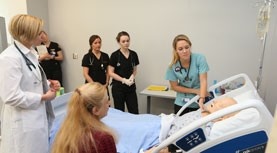About
What is Interprofessional Education?
“Interprofessional education occurs when students from two or more professions learn about, from, and with each other to enable effective collaboration and improve health outcomes. Once students understand how to work interprofessionally, they are ready to enter the workplace as a member of the collaborative practice team. This is a key step in moving health systems from fragmentation to a position of strength.”
World Health Organization (WHO). (2010). Framework for action on interprofessional education & collaborative practice. Geneva: World Health Organization
Health students have traditionally been educated in professional silos, with minimal interaction with students or practitioners in other professions. As communities across Canada move toward collaborative care team models, the health-related programs at Dalhousie University are committed to providing their students with a wide-range of interprofessional experiences and opportunities - through both curricular and extra-curricular activities.
Why Interprofessional Education?
Patients receive better care when health providers from all health disciplines work closely and learn from both their patients and other health care colleagues. Collaborative practice:
- Improves patient outcomes
- Reduces errors and improves patient safety
- Improves health professional satisfaction
- Reduces stress amongst health care providers and increases efficiencies and innovations
At Dalhousie, collaboration starts in the classroom with interprofessional activities designed to enhance knowledge, understanding and respect for the expertise, roles and values of other health and human service professionals. Our students learn that collaboration is all about the patient or client, their family and the community in which they live – not about the profession or the professionals. The patient/client/family are an important part of the healthcare team.
Collaboration starts here

Since opening in 2015, the Collaborative Health Education Building (CHEB) fosters even greater collaboration between the university's 3,700 Medicine, Dentistry and Health Professions students who come together under one roof for an integrated learning experience.
One of the only facilities of its type in Canada, the CHEB offers state-of-art classrooms, simulation labs in the Centre for Collaborative Clinical Learning and Research and study space in the Kellogg Library Learning Commons. This collaborative space provides students the opportunity to learn with, from and about each other in an environment that more accurately reflects real-world health-care practice.
Bringing a vision to life

Over the last ten years, interprofessional education at Dalhousie has gone from a vision to a reality through the tireless work and dedicated leadership of individuals across the University. Dalhousie is now an national leader in interprofessional education, and this is especially clear in the Collaborative Health Education Building, where the classrooms, library, labs and halls are filled with students gathering to learn about, from and with each other - enriching patient care and improving our healthcare system in the process.
Watch as Faculty leaders and students tell the story of interprofessional education at Dalhousie.
